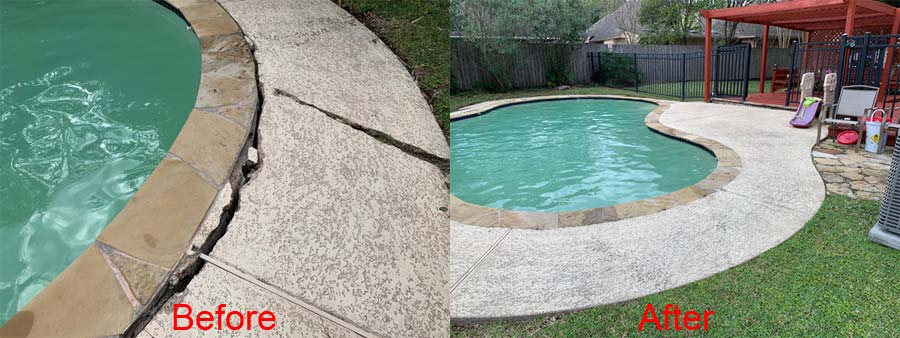Concrete Patio Restoration
When you bought your house, a big draw was the concrete patio in the backyard. You envisioned large family gatherings, entertaining friends and colleagues, and your personal favorite, quiet moments alone outdoor with your significant other. Time outdoors is not only enjoyable, but studies show there are emotional and health benefits from positive time spent relaxing outdoors. You did not anticipate a Concrete Patio Restoration project.
However, time has not been kind to the patio. While concrete is durable, it does require maintenance and repairs from time to time; perhaps you are seeing cracks, uneven surfaces, or discoloration. Your prime outdoor living space is now looking a little rugged. The good news is, if caught early, most concrete problems can be repaired, and your outdoor oasis restored. Instead of “just dealing” with concrete problems, here are some simple and cost-effective ways to revitalize cracked, sunken, and dirty patios.
Sunken or Uneven Concrete Slabs
A common concrete issue with large patio slabs is settling that creates uneven surfaces. Often patios are added as an afterthought and the yard may not have been prepared for proper stormwater drainage. Downspouts discharge stormwater directly onto the patio and eroding away the fill under the slab.
Not only is this unsightly, but it can create a tripping hazard and force water toward the foundation of the house instead of away. It is important to address drainage problems early to prevent major foundation damage. If unsupported, the concrete slab can also develop significant cracks that will eventually require replacement.
If this problem seems unsurmountable to you, take heart—solving this problem is a lot easier than you might think. Modern materials and advanced application equipment can fix the problem quickly and at a fraction of the cost of replacement. Small holes are drilled through the concrete slab and high-density polyurethane foam is injected under the slab where it expands to fill the void and bring the slab to its original position. The injection holes are filled, and the concrete surface restored for a seamless appearance. The polyurethane foam retains its shape and will neither shrink nor erode away. The repair process takes only few hours, and the results are remarkable.
Stained or Dirty Surfaces
Concrete is porous and will pick up dirt and stains from the local environs. Many organic stains develop from sap, pollen, leaves or flowers, or neighboring trees and shrubs. This may lead you to believe the patio needs to be completely resurfaced or replaced. While resurfacing products are available and the results can be amazing, they can also be expensive.
If the surface of your patio is dark or mottled, the first recommendation is to power wash it thoroughly. Water under pressure (at least 3000 psi) will take most stains and dirty off; cleaning chemicals can be added to the water for stubborn stains. The stains will respond to the direct stream of water, so take your time and clean the patio thoroughly. Orbital attachments are available for best results. You will be pleased with the way the brighter, renewed surface looks.
Cracks and Joints
As concrete cures, it also shrinks, causing cracks to form. When your concrete patio was poured, the installers left seams and may have cut joints in the surface to promote cracking in strategic locations so they would be less noticeable. As concrete continues to age, water can fill the cracks and cause further damage. Lots of rain can seep through the cracks to erode the fill under the slab and you have heard about the potential damage that causes. In areas that experience freezing temperatures, water in the cracks will freeze and widen the cracks.
Small cracks are normal and not necessarily a problem. However, joints and large cracks should be filled with good silicone caulk to prevent further damage. If the crack is filled, it will not hold water or let water seep through to the fill below. Silicone caulk is the right product since it will dry and remain flexible, it is not damaged by UV light, and it will not shrink or crack. Silicone caulk can match the color of the slab, giving you a clean, pleasant appearance.
Proactive Care
Water is the mortal enemy of concrete. You might assume that something so hard would shed water, and most water rolls off or evaporates. However, as concrete cures, air pockets develop, allowing it to absorb water like a sponge. Water is not kind to concrete. It can slowly leach the bonding agents away. Freezing, thawing, and scattering rock salt to speed the thawing of ice and snow, are all damaging to the surface of the concrete.
Water damage on the surface of a concrete slab may appear as scaling, flaking, or small pop-outs. To prevent water damage, you should apply a water repellant sealer, much like you would seal a wooden deck. We recommend a good penetrating sealant rather than an acrylic sealant for best results. This choice will last longer, 5-10 years compared to 2 years for an acrylic sealant and will not change the color or texture of the concrete surface.
Give Leveled a Call
Leveled offers leveling, power washing, caulking, and sealant services.
LET US HELP WITH YOUR CONCRETE Patio Restoration
When you are ready to fix that uneven concrete, call us at 832-995-2000 to schedule your free inspection for concrete repair. Leveled can schedule a free inspection to help with your concrete patio restoration.

